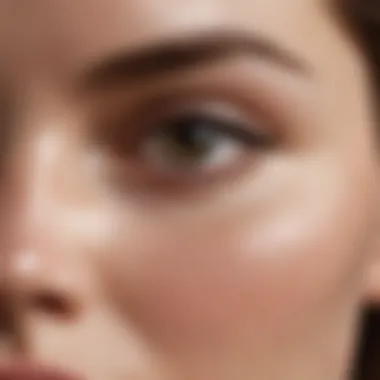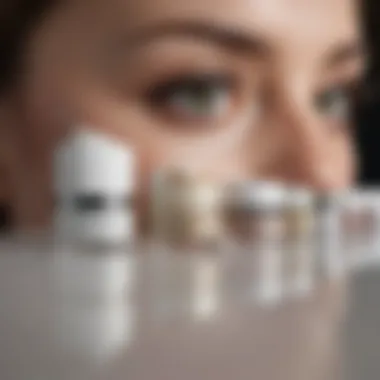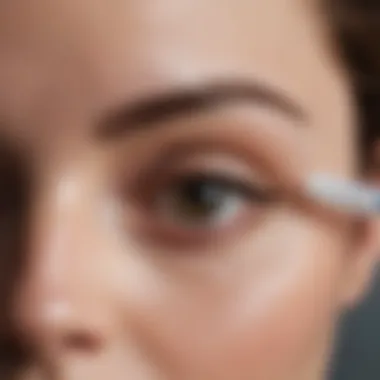Top Eye Creams to Combat Aging Effectively


Intro
Aging is a natural process, yet many seek solutions to maintain a youthful appearance. The area around the eyes is particularly susceptible to signs of aging, including fine lines, dark circles, and puffiness. This delicate skin requires specialized attention. Eye creams designed for aging prevention can make a significant difference. They utilize a variety of ingredients that target multiple signs of aging, ensuring the eye area remains vibrant and youthful.
In this article, we discuss the most effective eye creams currently available. Our approach incorporates scientific analysis of key ingredients, user experiences, and expert opinions. This ensures a well-rounded perspective that accounts for both efficacy and user preference. Over the coming sections, we will dissect the components of eye creams, explore application techniques, and compare the merits of leading products in the market.
Understanding the Importance of Eye Care
Eye care often tends to be overlooked in comprehensive skincare routines. However, the delicate skin around the eyes demands special consideration due to its unique characteristics. This skin is thinner and more sensitive than the rest of the face, making it prone to various aging signs such as fine lines, dark circles, and puffiness.
An effective eye care regimen not only helps in maintaining the skin’s youthful appearance but also contributes to the overall health of the skin. The eye area muscles are constantly in motion with expressions and blinking, which leads to the early onset of wrinkles. Additionally, external factors like UV rays, environmental pollution, and lifestyle choices can further exacerbate these issues. Thus, incorporating a targeted eye cream equipped with powerful anti-aging ingredients can provide much-needed protection and support.
Why the Eye Area Requires Special Attention
The eye area is subject to significant changes over time. With age, the skin's natural elasticity and moisture levels decline. This area requires specialized care since it does not have as many oil glands as other facial regions, leading to dryness and increased visibility of aging signs. Moreover, the area is more susceptible to dark circles because of limited blood circulation and fatigue. Addressing the needs of this sensitive region can significantly improve one’s overall appearance and wellbeing.
Signs of Aging Around the Eyes
Fine Lines
Fine lines typically appear first around the eyes, known as crow's feet. These small wrinkles develop from repeated facial movements and can be exacerbated by environmental stressors. Their significance stems from their visibility; as they deepen, they contribute to an aged appearance. Fine lines often respond well to eye creams containing retinol, which promotes cell turnover and smooths skin texture, making them a popular choice in anti-aging regimens.
Dark Circles
Dark circles present as a shadow-like effect under the eyes and can stem from a variety of factors, including genetics, fatigue, and dehydration. Their key characteristic is their ability to make an individual look tired or older than they are. The skin around the eyes can become discolored due to poor circulation or pigmentation issues. Eye creams containing brightening agents like vitamin C or caffeine can combat this issue by improving circulation and reducing pigmentation, making dark circles a crucial focus for effective eye care.
Puffiness
Puffiness under the eyes creates a swollen or baggy appearance and can be the result of fluid retention, lack of sleep, or allergies. It is often one of the most noticeable signs of fatigue and contributes to an overall tired look. Targeted eye creams with caffeine are effective in reducing puffiness through their ability to constrict blood vessels. Addressing puffiness can vastly enhance one’s appearance, making it essential to include this concern in eye care discussions.
Key Ingredients in Anti-Aging Eye Creams
The selection of eye cream can significantly influence skin health and aging. Understanding key ingredients in anti-aging eye creams is critical. These ingredients not only help combat existing signs of aging but also work preventatively to ensure a youthful appearance over time. Each component plays a role in enhancing skin texture, firmness, and overall vitality.
Retinol and Its Benefits
Retinol is a form of vitamin A. It is recognized for its powerful effects on skin renewal. Retinol increases skin cell turnover, which helps to reduce the appearance of fine lines and wrinkles. By promoting the production of collagen, it can provide firmer skin. However, retinol can be irritating, especially for sensitive skin. It is essential to start with a lower concentration and gradually increase usage. Always complement retinol application with sunscreen, as it can make the skin more susceptible to sun damage.
Peptides: The Building Blocks of Youthful Skin
Peptides are chains of amino acids and play a crucial role in skin health. They help stimulate collagen production, which is vital in maintaining skin elasticity. By incorporating peptides into an eye cream, users may experience firmer and plumper skin around the eyes. Additionally, peptides assist in repairing the skin barrier, improving hydration and reducing redness. This ingredient is particularly beneficial for those looking to enhance skin resilience and diminish the visible signs of aging.
Hyaluronic Acid for Hydration
Hyaluronic acid is a natural substance found in the skin, known for its ability to retain moisture. One gram of hyaluronic acid can hold up to six liters of water. When used in eye creams, it hydrates the delicate skin around the eyes. Well-hydrated skin appears fuller, reducing the appearance of fine lines. Moreover, hyaluronic acid promotes a smoother skin texture, making it an essential ingredient in any anti-aging regimen. Those with dry skin will find this component particularly advantageous.


Antioxidants: Protecting Against Environmental Damage
Antioxidants are crucial in the fight against skin aging. They neutralize free radicals, which are unstable molecules that damage skin cells. Common antioxidants in eye creams include vitamin C, vitamin E, and green tea extract. Regular use of products containing these ingredients may protect the skin from environmental stressors, such as pollution and UV rays. This protection can help maintain the skin's youthful appearance, making antioxidants a necessary part of an effective eye cream.
Caffeine and Its Role in Reducing Puffiness
Caffeine is not just for the morning cup of coffee; it serves a valuable purpose in skincare as well. Caffeine constricts blood vessels, which can effectively reduce puffiness and the appearance of dark circles. When applied topically, it has been shown to dehydrate and reduce swelling, leading to a more refreshed appearance. Eye creams with caffeine are ideal for those who often experience fatigue or bloating around the eyes.
How to Choose the Right Eye Cream
Choosing the right eye cream is crucial for those who want to maintain a youthful appearance and combat signs of aging. With various options available, understanding how to select the most suitable product can be overwhelming. Proper selection can lead to better results, while poor choices may cause irritation or even worsen existing issues.
Identifying Your Skin Type
Understanding your skin type is the foundation of selecting an appropriate eye cream. Skin types generally fall into four categories: oily, dry, combination, and sensitive. Each type may require different formulations.
- Oily Skin: Those with oily skin should look for light, gel-based eye creams. Products with non-comedogenic properties prevent clogging pores and reduce the risk of breakouts.
- Dry Skin: For dry skin, thicker creams rich in moisturizing ingredients like hyaluronic acid or shea butter offer essential hydration. These products often provide a soothing effect on the skin, helping to combat flakiness.
- Combination Skin: If you have combination skin, it’s best to use a cream that balances hydration without overwhelming oily areas. Lightweight formulations with a balanced formula can work well.
- Sensitive Skin: If your skin is prone to irritation, opt for fragrance-free and hypoallergenic products. Ingredients like chamomile or aloe vera are typically gentle and help reduce redness.
Recognizing these factors will guide you toward the best product for your specific needs.
Understanding Product Labels
Product labels can tell you a lot about the effectiveness of an eye cream. Reading labels closely can help you make informed choices. Here are key aspects to consider:
- Active Ingredients: Check for ingredients known for anti-aging benefits, like retinol, peptides, or vitamin C. Understanding their purpose ensures you are selecting a product that targets your specific concerns.
- Purpose Statements: Labels often claim various effects, such as "reducing dark circles" or "smoothing fine lines." Look for unbiased feedback and clinical studies supporting these claims.
- Fragrance and Dyes: Some creams contain artificial fragrances or dyes, which can cause skin irritation. If you have sensitive skin, prioritize labels that mention "free from fragrances."
- Expiration Dates: Always check for expiration dates. Ingredients may lose effectiveness over time, making it critical to use products within their optimal range.
These considerations help prevent the common pitfall of being swayed by marketing buzzwords without substantial backing.
Consulting with Skincare Professionals
Seeking advice from skincare professionals such as dermatologists can significantly improve your eye cream selection. These experts can offer personalized recommendations based on your skin conditions and concerns.
- Skin Assessments: Professional consultations often involve skin assessments that determine hydration levels, sensitivity, and other factors affecting your eye area.
- Product Recommendations: Dermatologists may suggest specific brands or formulations that have worked well for their patients. Their insights can guide you to high-quality products with proven results.
- Custom Treatments: Some professionals can provide customized treatments, allowing them to recommend products tailored to your skin's exact needs.
Consulting a dermatologist ensures you receive tailored advice, maximizing your efforts in finding the right eye cream.
In summary, understanding your skin type, reading product labels carefully, and seeking professional guidance will significantly enhance your ability to choose the right eye cream. A well-informed choice contributes to a more effective anti-aging skincare routine.
Effective Application Techniques
Effective application techniques play a vital role in maximizing the benefits of eye creams. The skin around the eyes is delicate and requires a thoughtful approach to ensure proper absorption and minimize irritation. Mastering these techniques can enhance the effectiveness of active ingredients and promote a more youthful appearance. Applying eye cream correctly is not merely about where you place the product but how you apply it as well.
Gentle Tapping vs. Rubbing
The choice between tapping and rubbing is crucial. Gentle tapping is often recommended over rubbing. Tapping encourages circulation and allows the cream to be absorbed more effectively into the skin. It also minimizes the risk of stretching the skin, which can lead to further signs of aging. Most eye creams are formulated to be lightweight, so a little goes a long way.
To apply, use your ring finger. This finger exerts the least amount of pressure. Starting from the inner corner of the eye, lightly tap the cream around the orbital bone, moving outward. This method is less aggressive and protects the sensitive skin from damage.


Timing: When to Apply Eye Cream
Timing is another important factor. Ideally, eye cream should be applied twice a day—once in the morning and again in the evening. Applying eye cream in the morning can be beneficial for combating puffiness and dark circles, often caused by sleep or fluid retention from overnight rest. Evening application allows for deep nourishment as the skin repairs overnight.
Make it part of your routine after cleansing but before moisturizer. This order ensures the eye cream penetrates effectively.
Layering Products: What Comes First?
Understanding layering is essential for those using multiple products in their skincare routine. Generally, the thinnest products should go on first. The recommended order is: cleanse, treat (which includes eye cream), moisturize. Applying eye cream after your serum can be advantageous, as serums are often rich in active ingredients that can enhance overall results.
However, never forget the importance of sunscreen during the day. If using an eye cream containing SPF, it should be the last step of your morning routine.
"Proper application and layering techniques can significantly amplify the efficacy of your eye creams, ensuring you gain maximum benefits from your skincare efforts."
Understanding these techniques can empower users to make the most of their eye creams. Consistent and correct application preserves the delicate eye area, fighting the visible signs of aging effectively. By being mindful of how and when to apply eye care products, you position yourself to achieve optimal results.
Top Eye Cream Recommendations
Selecting a suitable eye cream is crucial for anyone committed to addressing the visible signs of aging around the eyes. The delicate skin in this area is often the first to reveal stress, fatigue, and environmental damage. Through careful consideration of various options, individuals can identify products that combine efficacy with their specific needs. In this section, we will explore luxury brands, affordable options, and dermatologist-approved products, ensuring a comprehensive overview of the best eye creams available in the market.
Luxury Brands Worth Considering
Luxury eye creams often prioritize high-quality ingredients and advanced formulations. Brands like La Mer and Skinceuticals focus on the science behind skincare, delivering products that promise both immediate and long-term benefits. La Mer's The Eye Concentrate contains nutrient-rich sea kelp to hydrate and brighten the skin.
Skinceuticals, on the other hand, involves a more clinical approach with its A.G.E. Eye Complex, targeting dark circles and puffiness effectively. These brands distinguish themselves not only through sophisticated ingredients but also through a commitment to research and development. Investing in these products can yield significant benefits for individuals who prioritize quality.
Affordable Options with Proven Results
High-quality skincare does not always require a hefty price tag. There are many affordable options in the realm of eye creams that deliver excellent results. For instance, CeraVe offers an eye repair cream that includes ceramides and hyaluronic acid, effectively moisturizing and restoring the skin barrier without breaking the bank.
Similarly, Neutrogena’s Hydro Boost Eye Gel-Cream harnesses the power of hyaluronic acid to bind moisture and combat dryness. These products provide essential benefits while remaining budget-friendly, appealing to a wider demographic without sacrificing efficacy.
Dermatologist-Approved Products
Dermatologist-approved eye creams are recognized for their reliable formulation and effectiveness. Brands such as Olay and RoC have established solid reputations in the skincare industry. Olay’s Regenerist Retinol 24 Night Eye Cream features a unique retinol complex that works overnight. This particular cream has gained accolades from dermatologists for its ability to reduce signs of aging.
RoC’s Retinol Correxion Eye Cream is another recommended product, targeting puffiness, dark circles, and crow's feet. It combines retinol with a precise blend of antioxidants, offering a well-rounded solution for aging signs. Choosing dermatologist-recommended products ensures a level of trust and assurance in the effectiveness of the formula.
"Investing in a good eye cream can be one of the most impactful decisions for your skincare routine."
Overall, the right choice in eye creams requires thoughtful consideration of product quality, intended results, and individual skin needs. The market offers a vast array of options, from luxury to budget-friendly products. Understanding what each brand represents and how their ingredients work can empower informed decisions.
Common Misconceptions About Eye Creams
Understanding the common misconceptions regarding eye creams is essential when selecting a product that truly meets individual needs. Many consumers have formed beliefs based on anecdotal evidence rather than scientific facts. This section aims to clarify these misunderstandings and guide readers in making informed decisions.


Do All Eye Creams Work the Same?
This notion is misleading. Not all eye creams serve the same purpose or use the same ingredients. Eye creams can vary significantly in formulation, targeting specific issues like wrinkles, puffiness, or dark circles. For example, a cream with hyaluronic acid may focus on hydration, while one containing caffeine targets puffiness. Users often assume that any eye cream can resolve all under-eye concerns, while in reality, the effectiveness often depends on the ingredients used and the individual’s skin type.
When choosing an eye cream, it is vital to assess the active components and their intended effects. Some may contain antioxidants to fight free radicals, while others might include peptides for promoting collagen production. This specificity underscores the importance of correlating product choice with personal skin concerns rather than relying on a one-size-fits-all approach.
Are Expensive Products Always Better?
Price does not always equate to quality in skincare. Many consumers believe that higher-priced products are more effective, but this is not universally true. While it is common for luxury brands to invest in research and development, marketing often plays an inflated role in the pricing of skincare products. There are numerous affordable options that contain effective ingredients and deliver tangible benefits.
Several high-end products boast exceptional ingredients, yet there are also drugstore brands that use comparable formulations. Research and reviews can help in identifying reasonably priced products that yield good results. Ultimately, efficacy is determined by ingredients and formulation rather than mere cost. Hence, critical assessment of both expensive and affordable eye creams can lead to better decisions.
"The effectiveness of an eye cream should be judged more on its ingredients than its price tag."
Building a Comprehensive Skincare Routine
A well-rounded skincare routine is essential for maintaining youthful skin. Age-related changes do not just happen around the eyes. They occur on the entire face and body. Neglecting other areas during your routine can hinder the effectiveness of the eye creams you use. Thus, integrating eye care with broader skincare practices is crucial.
Integrating Eye Care with Other Products
It is important to note that eye creams work best when part of a larger skincare strategy. The skin around the eyes is thinner and more sensitive, thus requiring gentler products. Here are some considerations to keep in mind:
- Cleansing: Start with a gentle cleanser. This prepares the skin for other treatments. If your skin is clean, the eye cream will be more effective.
- Moisturizers: Follow with a moisturizer that suits your skin type. Hydrated skin allows the eye cream to penetrate better. Make sure to apply the eye cream after moisturizing to prevent any barriers.
- Serums: Use serums that can target issues such as wrinkles or inflammation. Apply these to the rest of your face, avoiding the eye area, unless products are specifically formulated for this.
- Facial Oils: These can enhance hydration levels. If using an oil, apply it after your eye cream. This helps lock in moisture beneath the oil layer.
By taking these steps to integrate eye care, you create a holistic approach to skincare that maximizes the benefits of your eye cream.
Sun Protection: An Often Overlooked Factor
Sunscreen is critical, yet often underestimated in skincare routines. Ultraviolet rays can cause premature aging, leading to wrinkles and sagging skin. It is essential to protect the skin not just on your face but around the eyes.
- Daily Use: Apply a broad-spectrum sunscreen every day, even on cloudy days. UV rays can penetrate through clouds and windows.
- Targeted Application: Make sure to use a sunscreen that is suitable for sensitive skin, especially around the delicate eye area. Consider products with zinc oxide or titanium dioxide for their gentle properties.
- Reapplication: Reapply sunscreen every two hours, particularly if you spend time outdoors. Consider using a powdered sunscreen for easy application over makeup.
Incorporating sun protection in your routine may seem redundant but its benefits are indispensable for preventing aging.
"Investing in sun protection is investing in your skin's future."
By addressing these elements, your skincare routine not only supports the efficacy of your chosen eye cream but also contributes to overall skin health.
Final Thoughts on Eye Cream Selection
When selecting an eye cream, it is essential to recognize the tremendous variety of products available and the necessity of a discerning approach. Eye creams are not just an added luxury in a skincare routine; they play a crucial role in maintaining the delicate skin around the eyes, a region more susceptible to visible signs of aging. Given that many people seek solutions for common concerns such as fine lines, dark circles, and puffiness, understanding the elements that contribute to effective eye care is vital.
Efficacy vs. Marketing Hype
The allure of eye creams often lies in the promises made by marketing strategies. However, it is paramount to differentiate between genuine efficacy and mere hype. Many brands tout their products as revolutionary, claiming instant results. Yet, the reality can be more nuanced. Evaluating the ingredients backed by scientific research can ground choices in fact rather than advertising claims.
For example, ingredients like retinol and hyaluronic acid have been studied extensively for their anti-aging properties. In contrast, some products may feature a high price tag but lack any clinically proven ingredients. Whether a product is marketed as premium or standard, understanding what works is the key to making informed decisions. Consider researching and reading reviews on platforms such as Reddit to form a more holistic view.
Individual Results Vary: What Works for One May Not Work for All
An essential concept in skincare is that individual results can significantly differ. Each person's skin type, lifestyle, and even genetic factors play a critical role in how products perform. What benefits one person may have little to no effect on another. Therefore, it is crucial to approach eye cream selection with an open mind and realistic expectations.
For instance, a cream that works wonders for someone with dry skin may be ineffective for someone with oily skin. Those looking for specific results should consider their unique concerns and test various products over time. Patience is often necessary, as is consulting professionals when unsure about choices. Reading user reviews and understanding personal experiences from sources like Britannica can offer valuable insights into diverse perspectives on product effectiveness.



